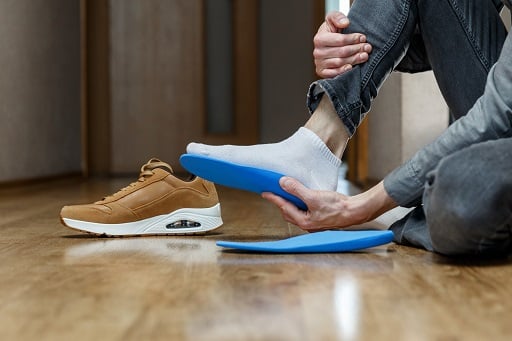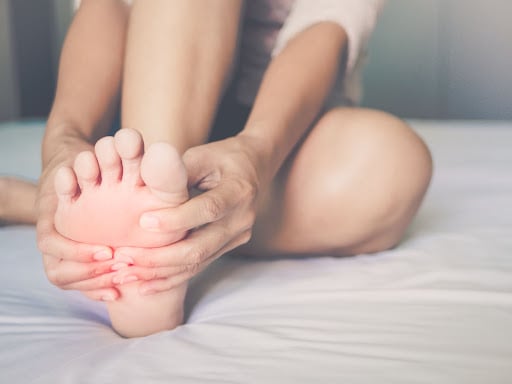When you have plantar fasciitis, the simplest activities you once took for granted can, at times, seem unendurable. Going for long walks, standing in barely-moving check-out lines, or just swinging your feet over the bed to get up in the morning can inflict intense pain that could have you rethinking the importance of feet altogether.
But don’t take it out on those two champions who keep you upright and mobile daily! 1 in every 10 people develops plantar fasciitis, and if you’re one of them, there are ways to bolster your comfort.1 For many people, it starts with a quality pair of orthotic inserts.
That said, choosing the best pair isn’t as simple as grabbing the first ones you see on the rack. Below, we explain the difference between soft and hard orthotics, how to decide between them, and ways you can support your plantar fasciitis thereafter.
Hard vs Soft Orthotics for Plantar Fasciitis: What’s the Difference?
When it comes to orthotic insoles, there are many options in styles, texture, and design. Many people have custom-made orthotics modeled after the exact morphology of their feet, but studies indicate that even off-the-rack orthotics can be incredibly effective for alleviating the symptoms of plantar fasciitis.
Even so, you’ll still need to make certain decisions surrounding types of orthotics, such as whether to opt for soft or hard designs. Before we dive into how to choose between them, let’s look at how they differ.
Soft Orthotics
Most soft orthotic inserts are made with an elastic but durable thermoplastic known as ethylene vinyl acetate (EVA)2. Many people consider these to be the more comfortable option by virtue of their adjustability. Soft orthotics are also wonderful for reducing the likelihood of rubbing, which can often lead to blisters and sores. However, there are ways to prevent blisters when running and doing other daily activities.
Compared with hard orthotics, soft orthotics offer:
- Softer padding
- More adaptability
- Lower price points
If you’re debating between hard or soft orthotics for plantar fasciitis, keep in mind that soft orthotics are overall more lightweight than most hard orthotics. This can make it easier to find a perfect fit when worn with a wider variety of shoe styles.
Hard Orthotics
Hard orthotics switch out EVA for a material called polypropylene.2 Although they may be slightly less comfortable than soft orthotics, they offer a range of benefits that many people with plantar fasciitis appreciate, such as:
- Durability – You’re likely to get a bit more mileage out of your hard orthotics than your soft ones. They tend to last longer and are more resistant to compression and flattening.
- Less reliant on shoes – That durability means that hard orthotics aren’t easily influenced by the shoes you wear with them. They can hold their shape and provide support when used with various shoe styles.
- More supportive – Hard orthotics may offer more support than their soft counterparts. Because they don’t depend on the shoes you wear to hold their shape, they can equitably distribute different amounts of support to different areas of your feet.

5 Things to Consider When Choosing Between Soft or Hard Orthotics
At first glance, the difference between hard and soft orthotics can seem straightforward—one is more durable, while the other is more pliable.
However, this distinction can make a big difference when it comes to plantar fasciitis recovery and overall wearing experience. With that, let’s look at 5 factors before choosing the type of foot orthotics that’s right for you.
#1 Level of inflammation
At its core, plantar fasciitis is an inflammatory foot disorder. It refers to the inflammation of the plantar fascia ligament, a band of tissue that runs the entire length of your foot from heel to toe. It is one of your feet’s most important components.
Additionally, plantar fasciitis can also come with swelling of the heel and uncomfortable tightness in the Achilles tendon, which runs in the opposite direction from your heel to your calf muscle. Several factors may cause this, including:
- The height of your arch
- Your body weight
- How much time you spend on your feet
- The activities you partake in regularly
If your plantar fasciitis is characterized by excessive swelling, you may gravitate towards soft orthotics. These tend to be more forgiving than hard orthotics, lending extra room for your feet when inflamed or swollen.
#2 Level of pain
Foot pain is the most prominent symptom of plantar fasciitis. For most people, this pain typically manifests in one of two ways:
- Tender – Tenderness is often compared to the sensation you’d experience when applying pressure to a bruise. In this case, the bottoms of the feet can feel tender and highly sensitive to even the tiniest amount of weight.
- Sharp – For others, plantar fasciitis pain feels hot, sharp, and immediate. This tends to localize on or near the bottom of the heel where the ligament attaches to the heel bone, although arch pain is also common.3
People with “tender” type plantar fasciitis pain may prefer to wear soft orthotics over hard ones. Here, the supple nature of the material can offer support while minimizing impact at the site of discomfort.
That said, by providing extra support to the foot, both soft and hard orthotics can be effective for reducing both types of pain in the long term.
#3 Tolerance for discomfort
While hard orthotics are very supportive, they typically take longer to break in—and, for some people, this adjustment period can be a hassle or a headache. When deciding between hard or soft orthotics for plantar fasciitis, ask yourself how quickly you expect to see results. Hard orthotics might not be the way to go if you’re looking for immediate relief.
Moreover, athletes or anyone who maintains an especially active lifestyle may also want to avoid hard orthotics. This is because hard orthotics are not as flexible as soft ones, and the constant bending and pressure exerted by exercise can sometimes lead to breaking, cracking, or other structural damage.2
#4 Budget
There are a variety of factors that might impinge on your budget when weighing soft vs. hard orthotics. In general, soft orthotics are an effective option that is slightly more budget-friendly than hard orthotics. That said, three factors that can make soft insert a modicum more expensive:
- Lesser durability – Soft orthotics tend to wear down more quickly, which could mean you have to replace them more frequently than you would hard ones. Likewise, they tend to retain heat more easily, which in some cases leads to shorter shelf life.
- Lack of internal support – The efficacy of soft orthotics hinges on the shoes you pair them with. Depending on the structural support offered by shoes you already have in your closet, you may need to purchase another pair shoes of shoes to wear with your soft orthotics.2

Is Plantar Fasciitis Treatable with Orthotics?
Does plantar fasciitis go away? Plantar fasciitis is one of the most common podiatric concerns out there, and if you’re working on managing yours, there’s good news: The condition is usually fully reversible without extensive medical procedures or costly appointments with a physical therapist. With proper treatment, most people can cure plantar fasciitis within months of first noticing symptoms.
So, do orthotics help improve plantar fasciitis symptoms?
Yes. According to several studies, outfitting your shoes with the right set of orthotic inserts can reduce pain from plantar fasciitis and improve foot function.4
In addition to recruiting the help of orthotics, making sensible, non-invasive adjustments to your foot care routine can help you heal. In practice, this could look like:5
- Regularly wearing supportive footwear with substantial arch support, cushioned insoles, and a stabilizing design to keep you comfortable as you recover.
- Wearing shin splints at night to provide stability in the nighttime.
- Home remedies like foot massage, ice baths for your feet, and regularly stretching your calf and foot muscles before bed and upon waking each day.
- Taking anti-inflammatory medications to relieve pain and swelling
- Taking a break from rigorous exercise and trying milder sports (like swimming) that don’t require excessive standing
Remember, the human foot is an amazing and complex piece of machinery. Dexterous, sturdy, agile—and the foundation of your entire body—each foot is made up of dozens of bones, countless ligaments (the plantar fascia ligament among them), and over 100 distinct muscles.3 And when you take preventative measures to show even just one of them some love, the rest of the foot sends it right back to you.
Find Relief From Plantar Fasciitis Pain at Vionic
If you suffer from plantar fasciitis, pain relief is likely at the forefront of your mind. Sore heels, aching arches, and tight tendons and calves can all shorten your stride and keep your feet from doing what they evolved to do: provide support.
Fortunately, side-stepping foot pain can be as simple as adjusting the shoes you wear each day. Vionic’s insoles and footwear are fashionable, functional, and designed alongside podiatrists to provide unrivaled support and all-day comfort.
If you’re coping with plantar fasciitis or other foot-related discomforts, it’s time to get support that won’t cramp your feet or your style. To start building foot health from the ground up, browse Vionic’s vibrant collection of stylish, comfortable shoes today.
How Do Orthotics Help with Plantar Fasciitis?
The human foot is an amazing and complex piece of machinery. Dexterous, sturdy, agile, and the foundation of your entire body, each of your feet is built of dozens of bones and joints and over 100 distinct muscles.
Unfortunately, anyone of those muscles, bones, or joints could become damaged or injured. This is why knowing how to find the right footwear, such as running shoes, for your feet is so essential. The stress and strain of standing, walking, running, and everything else you use your feet for can wear them out, leaving you with temporary or ongoing ailments that leave you feeling a bit less than sure-footed.
The main duties of the plantar fascia muscle are:
- Absorbing shock and pressure
- Providing arch support
- Supports body weight
Any of those tasks would be a tall enough order on their own, but the plantar fascia does all three. And even though they are tough, durable ligaments, bearing so much responsibility can really take it out of them. Is it any wonder that about 1 out of every 10 people develop plantar fasciitis?1
You can experience plantar fasciitis at any time, but generally speaking, it is most noticeable:
- In the morning – For many people with plantar fasciitis, mornings are among the lowest points of the day. That said, the heel pain tends to decrease once you get up and start standing or walking around.
- After long periods of standing – Morning, noon, or night, spending too long standing in place can aggravate your plantar fascia muscle and increase pain. This is especially true when standing on hard, unforgiving surfaces or wearing shoes that don’t provide proper support.
- After exercising or working out – Working out at the gym, going for a run, or hitting the boxing ring can all aggravate plantar fasciitis pain. Typically, you won’t notice any additional pain during your exercise—but plantar fasciitis could complicate your post-workout recovery period.
Aside from choosing hard or soft plantar fasciitis insoles, you can also try a heel cup for the affected foot. If you ignore plantar fasciitis, it might trigger another foot problem (the Achilles tendon is particularly susceptible). So whether you choose soft or hard orthotic footwear, the important thing is you wear supportive shoes to help with pain relief.
Sources:
- “Plantar Fasciitis.”. American Academy of Family Physicians, 2019. https://www.aafp.org/pubs/afp/issues/2019/0615/p744.html#
- “Soft or Hard Orthotics – What Some Practitioners Won’t Tell You.” Well Heeled Podiatry, 23 March, 2022.https://www.wellheeledpodiatry.com.au/soft-or-hard-foot-orthotics
- “Plantar Fasciitis: Causes, Symptoms, & Treatment.” Cleveland Clinic, 29 June 2020. https://my.clevelandclinic.org/health/diseases/14709-plantar-fasciitis
- “Orthotics Compared to Conventional Therapy and Other Non-Surgical Treatments for Plantar Fasciitis.” PubMedCentral, December, 2015. https://www.ncbi.nlm.nih.gov/pmc/articles/PMC4742336/
- “Plantar fasciitis.” Mayo Clinic, 20 January, 2022. https://www.mayoclinic.org/diseases-conditions/plantar-fasciitis/diagnosis-treatment/drc-20354851


Leave a Reply